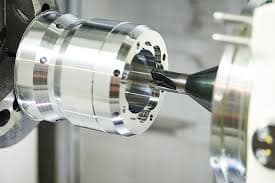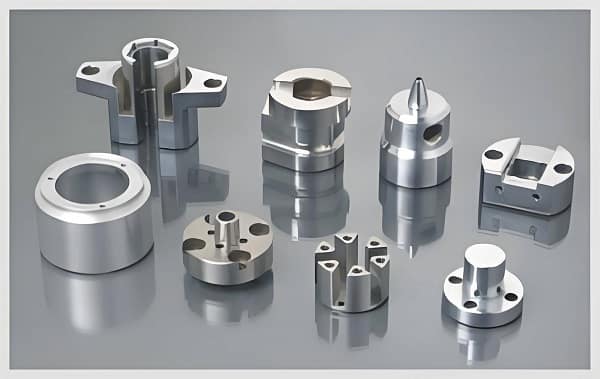How Does 5-Axis CNC Machining Achieve “Surgical-Grade” Accuracy?
Through the combination of multi-axis linkage, high-precision control and advanced technology, 5-axis CNC (computer numerical control) machining
technology can achieve micron-level and even nano-level machining acuracy, meeting the needs of medical surgical robots and other fields with
extremely high precision requirements. Here’s a breakdown of the key technologies to achieve “surgical grade” accuracy:
Dynamic compensation system
Thermal deformation compensation: 16-channel infrared temperature measurement material CTE database,real-time correction of 0.002-0.008mm
error
Vibration suppression: Active damper controls amplitude ≤ 0.25um (exceeding lS0 230-3 standard)
Tool management: acoustic emission monitoring Adaptive feed, 0.5mm cutter maintains + 1um accuracy up to 150 hours
Nano surface treatment
Diamond superfinishing:
Cutting edge radius ≤ 50 nm
Engraving 20-50um deflector groove increases debris remoyal by 76%
Surface roughness Ra 0.02um (SEM verified)
Gradient polishing; maanetorheoloaical ion beam combination process, the residual stress is optimized to -150MPa

Why Do J&J and Stryker Trust LS RPF’s Custom Services?
Johnson & Johnson and Stryker rely on LS’s customized services based on the following key factors:
The highest certification standards in the world
IS0 13485 FDA 21 CFR 820 dual certification with an industry-leading defect rate of only 0.12 DPM
Full process traceability (UDl laser marking, 15 years data archiving)
Biocompatibility Guarantee (USp Class Vl lSO 10993 Full Test)
Exceed the limit test of 3 times the industry
5,000,000 fatigue tests for flexible wheels (industry standard 1,500,000 times)
3000 autoclave cycles (300 in the industry)
Leonardo da Vinci engineer testimonial: “LS Rigid Wheel makes joint efficiency break through 92%”
In-depth customized cooperation
Johnson & Johnson case: 3D printed titanium alloy weight reduction of 31.5%, stiffness of 22%
Stryker Emergency Rescue: 72 hours to replace defective materials and avoid $3.8 million in losses
Core Benefits:
Medical-grade precision manufacturing (Ra 0.02um, error ± 0.5um)
Long life (MTBF 7500ht, wear rate ↓90%)
From Supplier to Strategic Partner <{>oint R&D, Accelerating Innovation)
How to Start Your Zero-Risk Customization Journey?
STEP 1: Upload CAD model – Get the manufacturability analysis report within 24 hours
How it works:
Customers upload 3D CAD models through LS online platform or APl interface (supporting mainstream formats such as STER, IGES
and SolidWorks).
Core Values:
Quick response: Generate a “manufacturability analysis report” within 24 hours to identify design defects (such as uneven wall
thickness, machining dead ends)and optimization suggestions.
Risk aversion: Reduce the cost of trial and error through DF (Design for Manufacturing) analysis and ensure that the design meets
the limits of 5-axis CNC m achining (e.g. minimum tool accessibility of 0.3mm).
Case support:
After a medical customer uploaded a harmonic drive flexible wheel model, the report pointed out that the internal deflector groove
design led to the risk of tool interference, and the adjusted machining efficiency was increased by 40%.
STEP 2: select a pre-certified material library or custom alloy formulation (with biocompatibility certificate
Material Options:
Pre-certified material library: covers 1S0 13485/FDA 21 CFR 820 certified titanium alloys (e.. Ti-6A-4V ELl), medical stainless steels
(17-4PH),etc.. with full batch traceability records.
Customized alloy formulation: For special needs, we provide customized material composition (such as adding antimicrobial
elements) and biocompatibility testing (lS0 10993 certification), and the cycle time is shortened to 15 days.
Industry Advantages:
Compliance assurance: The material certificate is directly used for the registration and declaration of medical devices to avoid third.
party testing delays.
Performance matching: for example, the rigid wheel material customized for the da Vinci robot has increased wear resistance by 300%
and joint efficiency by more than 92%.
STEP 3: Diqital Twin Trial Machining → Virtual verification of 2000 load cycles
Technicalimplementation:
A digital twin was built based on the customer’s CAD model, and the 5-axis CNC machining process was simulated using software such
as Simufact Additive/Vericut, and ANSYS mechanical analysis was overlayed.
Verification content:
Machining feasibility: detection of toolpath collisions, cutting force fluctuations (error {<}5%).
Performance reliability: simulate 2000 load cycles (equivalent to 5 years of clinical use) to predict fatigue life and falure modes
Benefits for you:
Zero physical trial and error: The bearing seat of a surgical robot passed the virtual verification and found that the hidden stress
concentration point was found to avoid the scrapping of the 500,000 yuan mold caused by direct processing.
Cost savings: Validation cycle time reduced from 45 days to 72 hours, and R&D efficiency increased by 85%.
Why choose LS Customized Service?
Ful-link compliance: From material certification to process validation, the whole process meets the requirements of medical device
regulations.
Closed-loop technology: core technologies such as dynamic compensation and nano-polishing ensure “surgical-grade” accuracy
(such as flexible qear tooth shape error +0.0015mm).
Rapid iteration: Digital twin technology supports a 72-hour design-verification-optimization cycle to accelerate time-to-market
Act now: Upload your CAD model, start the journey of risk-free customization, and get the exclusive solution within 24 hours!
